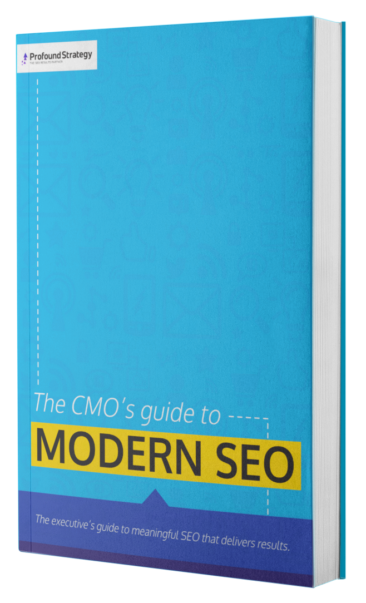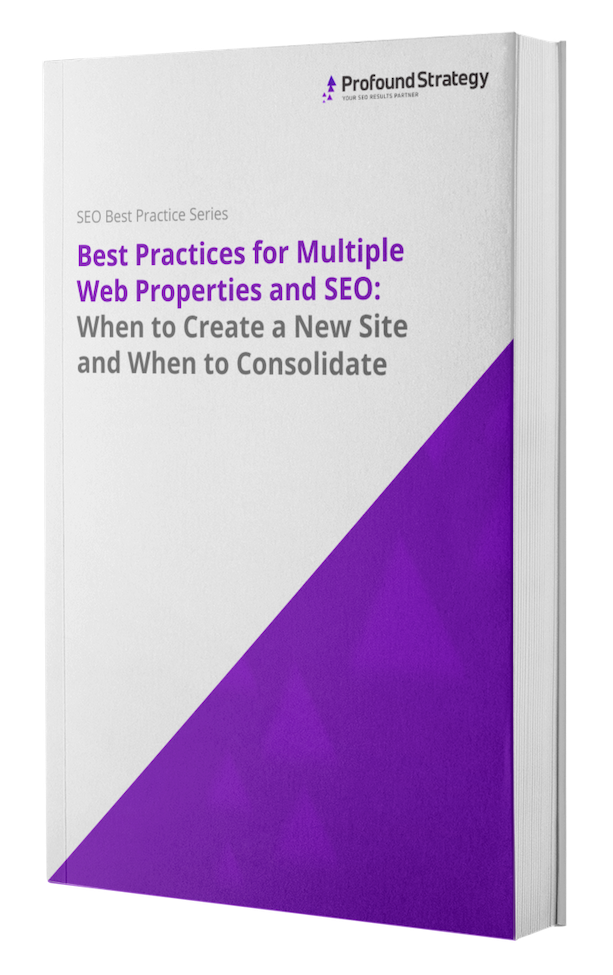Does Your Business Need Multiple Websites? What Google Has to Say
I admit I sat up a little straighter when I read Google’s recent article, “Inside Google Marketing: 3 ways we think about SEO.” My team and I have been advising clients and friends to—wherever possible—consolidate their online presence, and now Google has affirmed our strategy.
Of course, we always take official Google “advice” with a grain of salt. Google has never been purely interested in helping the SEO community, but, in this case, Google has nothing to lose.
So, if you’re considering a second website for a new business line, or a microsite for that upcoming event, allow me to echo what we’ve been saying for years—and what Google has now confirmed.
Or you can jump straight to the ebook that gives all the details. There’s even a very helpful flowchart that will help you figure out if it’s time for a second website.
Download Now!
Should I Build a Microsite?
Generally, marketers consider creating secondary or microsites to:
- Promote an upcoming event.
- Introduce a new product line.
- Try to rank multiple domains at the top of organic search results.
- To build links to the main company website.
The rational is usually that this event is so big, or this new product line is so distinct, that it doesn’t fit within the current brand. Some marketers think their current audiences would cringe at seeing it, or the new target audience would disdain finding it on the big brand’s website.
Other intentions may seem, as first blush, like easy SEO wins.
In the majority of cases, however, a second site drains resources and doesn’t deliver the SEO boost intended. Here’s why.
Three Reasons NOT to Build Multiple Websites
Let’s review some common misperceptions and look at what really happens when marketers set out to expand their online presence with another website.
1. A second site requires double the resources
A lot of thought, planning, and upkeep go into the creation of a successful, revenue-generating website. Before web developers and content creators can get to work, there are important questions to answer about the target audience, how to create a great user experience, brand effectively, and more.
And building SEO value is a continual work in progress. Planning and creating content that builds authority, improves rankings, inspires clicks, drives qualified traffic, and converts organic visitors into customers requires ongoing SEO and competitive research, A/B testing, and more.
To earn value from a second website, all of that effort—and all of those resources—double. There is no shortcut.
2. A second site splits the brand’s online authority
A women’s fashion brand launches a new line for teens and publishes a whole new site for their new audience. If both sites are committed to content marketing, they are both creating content about the latest styles, fashion events, and more. But which publisher is the online authority in women’s fashion? In hoping to create a runner-up in organic search, that brand has created a competitor.
In the end, rather than ranking both URLs, two sites usually end up fighting one another for a Page 1 spot.
3. A new site starts building SEO authority at zero.
Whether it’s to rank a second domain or build links back to the main brand site, marketers need to remember that a new site starts at square one.
It can take a long time to build the trust and authority needed to rank on page one of organic search results. It takes even longer to build enough SEO value to pass to the main site through backlinks.
Google grades links based on the authority of the site from which they point. Setting up a new site with lots of links back to the main web presence, is only going to send red flags flying in Google’s algorithm.
The Benefits of a Single Website
The other side of the coin is the massive benefits of consolidating your web presence when possible.
1. Efficient Use of Resources
When time and attention is focused on one site, the ROI multiplies. Let your digital marketing team focus on one site, one SEO roadmap, and one content strategy. That focus will drive one very successful web presence, which will boost all of your product lines, events, etc.
2. More Effective PR
Backlinks are important SEO signals, but Google is tired of being spammed by them. To be effective, they need to be genuine and authoritative. They need to be earned.
Rather than doubling SEO resources for a whole new site (that won’t have the authority to pass good backlinks anyway), put a fraction of that investment into building relationships, sharing content, and earning genuine backlinks from existing, authoritative sites.
3. Cross-Promotion
Cross-promotion rarely hurts, and more often works out surprisingly well.
The DevOps guy that makes up one part of your target audience, for example, might also be a new father thinking about saving for his kids’ future college education. So your “unrelated” new banking app is actually very relevant. What’s more, rather than causing any kind of dissonance, he trusts your new product more because he already trusts your brand.
When to Create Multiple Sites for One Company
Sometimes, albeit infrequently, it makes sense to have multiple sites:
- VERY different audiences — I’m still a fan of the power of cross-promotion, but there are times when one product line opposes the values of another’s audience.
- VERY different offerings — British multinational retailer Tesco has a website for groceries, another for banking, and a third that focuses on their corporation.
- The boss said so — It happens. When the multiple-site strategy tanks, higher ups may be willing to listen to your thoughtfully presented arguments.
Do You Need Multiple Websites?
Building and maintaining multiple sites is resource intensive and rarely worth the time and money. I’ve been saying it for years, and I’m glad to have some official backup from Google finally.
If you’re still not sure, get a free copy of Best Practices for Multiple Web Properties and SEO: When to Create a New Site and When to Consolidate. This ebook is part of our SEO Best Practice series and gives even more details. There’s also a flowchart to help walk you—one question at a time—through the decision.
What's Next?
Profound Strategy is on a mission to help growth-minded marketers turn SEO back into a source of predictable, reliable, scalable business results.
Start winning in organic search and turn SEO into your most efficient marketing channel. Subscribe to updates and join the 6,000+ marketing executives and founders that are changing the way they do SEO:
And dig deeper with some of our best content, such as The CMO’s Guide to Modern SEO, Technical SEO: A Decision Maker’s Guide, and A Modern Framework for SEO Work that Matters.







